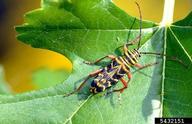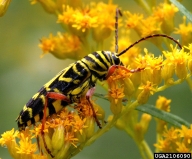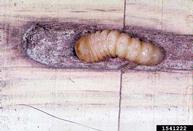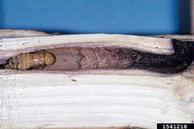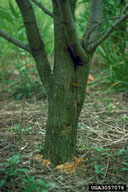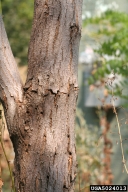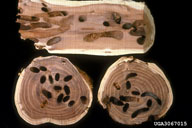Locust borer
Megacyllene robiniae (Forster) (Coleoptera: Cerambycidae)
Orientation to pest
Locust borer, Megacyllene robiniae (Forster), is native to the United States and bores in black locust (Robinia pseudoacacia L.) trunks. Attacks occur most often in young trees or in older trees stressed by drought or poor soil, or that have been overtopped by other trees. This borer formerly was limited to its native range in Pennsylvania, south in the Appalachian Mountains to Georgia and in the Ozark Mountains of Arkansas and Missouri. However, black locust has been widely planted outside this range and the borer is now found in those locations as well. Black locusts have been widely planted for restoration of strip-mined areas. Adults of locust borer emerge in late summer and are commonly seen feeding on pollen on field goldenrod (Solidago canadensis L.). Females lay their eggs in crevices of rough bark and around wounds of living trees. Larvae bore into the bark and construct overwintering cells. In the following spring, larval activity is resumed and sap may be seen oozing from the larval entry holes. Larvae bore into the wood and feed until they mature in mid-summer. During their feeding period, larvae tunnel extensively throughout the heartwood. Maturing larvae construct a tunnel to the exterior, through which adults later emerge. There is one generation per year. Attack is most common on stressed trees, such as those on reclaimed mining sites. Borer activity often results in wind breakage of trees, followed by excessive branching. Attack rates increase as the proportion of black locust in the stand increases, and larval to adult survivorship increases as the attack rate increases.
Hosts commonly attacked
Locust borer is a specialist that feeds only on black locust (R. pseudoacacia).
Distribution
Locust borer is found throughout the United States wherever black locust grows naturally or has been introduced.
Images of locust borer
| Figure 1. Adult locust borer, Megacyllene robiniae | Figure 2. Locust borer feeding on pollen of goldenrod (Solidago sp.) | Figure 3. Larvae of locust borer in feeding galleries |
| Figure 4. Pupa of locust borer in pupation chamber | Figure 5. Cracks, frass at base of tree, and emergence holes are signs of of locust borer activity | Figure 6. Locust borer larval galleries seen in cross and lateral sections | |
Important biological control agents related to this pest species
Two species of wasps, Dolichomitus irritator (Fabricius) and Habrolepoidea depressa (Girault), have been recorded parasitizing locust borer larvae at low rates (<1%). Natural enemies of locust borer have not been studied extensively.
Web links for information on locust borer
- Forest Insect & Disease Leaflet 71 | USDA Forest Service
- Article on locust borer and black locust trees | Washington State University Cooperative Extension
- NY Forest Owner Article | New York Department of Environmental Conservation
- Insect Note | Ornamentals and Turf, Department of Entomology | North Carolina Cooperative Extension
Articles
- Harman, D. M., M. A. van Tyne, and W. A. Thompson. 1985. Comparison of locust borer Megacyllene robiniae Forster (Coleoptera: Cerambycidae) attacks on coal strip-mined lands and lands not mined. Annals of the Entomological Society of America 78: 50-53.
- Harman, D. M., P. Rudolf, and K. R. Dixon, K. R. 1985. Influence of stand composition on locust borer (Coleoptera: Cerambycidae) attack rates. Journal of Entomological Science 20: 207-211.
- Echaves, V. D., D. M. Harman, and A. L. Harman, A. L. 1998. Site quality in relation to damage by locust borer, Megacyllene robiniae Forster in black locust. Journal of Entomological Science 33: 106-112.
